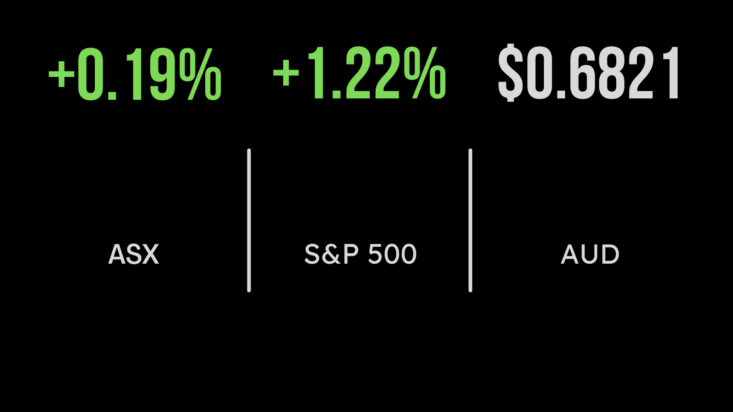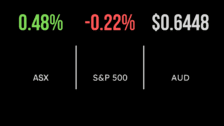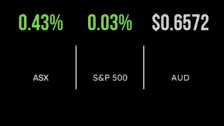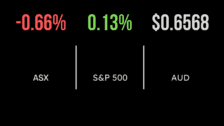Strong jobs number points to rate rise
The Australian share market rose for a fourth straight day, buoyed by Chinese stimulus measures in China, even as a booming domestic jobs report raised expectations for rate hikes, pushing the Australian dollar to its highest point since February.
The benchmark S&P/ASX200 index gained 13.6 points, or 0.2 per cent, to 7,175.30, while the broader All Ordinaries appreciated 15.8 points, also 0.2 per cent, to 7,370.0.
Australian May labour market data was much stronger than expected, with the Australian Bureau of Statistics reporting that employment in May rose by 76,000 — far more than the 17,500 expected by economists’ consensus — reducing the jobless rate to 3.6 per cent, from 3.7 per cent a month earlier. More than 14 million Australians are in jobs, which is a record; and a larger share of women in Australia are employed than ever before. The participation rate (those who are employed or actively seeking employment) rose 0.2 percentage points to a record high of 66.9 per cent.
But paradoxically, to some, the strong employment numbers raise the likelihood that the Reserve Bank will raise rates again in July. The RBA will be concerned that the tight labour market will feed into wages growth and keep inflation higher than its target band of 2—3 per cent.
Indeed, Australia’s yield curve inverted on Thursday for the first time since the financial crisis, after the jobs report was released, as bond traders increasingly priced in the risk of a recession. The gap between yields on ten- and three-year government bonds fell to minus one basis point, going negative for the first time since 2008.
The ASX-s 11 official sectors finished mixed, with seven up and four down.
Healthcare was the biggest mover, dropping 2 per cent as heavyweight CSL lost a further $7.75, or 2.7 per cent, to $279.50, as the market continued to mull over disappointing financial-year 2024 earnings guidance released Wednesday.
All of the Big Four banks made ground, with ANZ lifting 21 cents, or 0.9 per cent to $23.13;
Commonwealth Bank added 62 cents, or 0.6 per cent, to $97.99; National Australia Bank was up 14 cents, also 0.6 per cent, to $25.65; and Westpac strengthened 4 cents, or 0.2 per cent, to $20.60. Macquarie Group advanced $4.15, or 2.3 per cent, to $182.20; while “small major” Bendigo Bank retreated 5 cents, or 0.6 per cent, to $8.47.
Mining bag mixed
In the heavyweight materials sector, the big iron ore miners were higher on expectations of further China stimulus, while goldminers were under pressure. BHP added 35 cents, or 0.8 per cent to $46.25; Rio Tinto gained $1.60, or 1.4 per cent, to $117.75; and Fortescue Metals lifted 78 cents, or 3.6 per cent, to $22.48.
In gold, Newcrest fell 19 cents, or 0.7 per cent, to $25.89; Northern Star lost 24 cents, or 1.8 per cent, to $12.80; Bellevue Gold eased 3 cents, or 2.5 per cent, to $1.16; Gold Road Resources fell 6 cents, or 3.4 per cent, to $1.685; and Silver Lake Resources walked back 3.5 cents, or 3.4 per cent, to 99.5 cents.
In coal, Whitehaven Coal was up 15 cents, or 2.4 per cent, to $6.41; New Hope Corporation surged 23 cents, or 4.3 per cent, to $5.54; Coronado Global Resources strengthened 5.5 cents, or 4 per cent, to $1.44; and Stanmore Resources lifted 7 cents, or 2.8 per cent, to $2.56. Rail group Aurizon, which hauls most of the export coal to ports, was up 16 cents, or 4.5 per cent, to $3.73.
In lithium, the mood was different, with producer Allkem dropping 46 cents, or 2.9 per cent, to $15.60; fellow producer Pilbara Minerals surrendering 22 cents, or 4.5 per cent, to $4.66; IGO, which mines nickel and lithium, giving up 40 cents, or 2.6 per cent, to $14.74; and Mineral Resources, which produces iron ore as well as lithium, losing 92 cents, or 1.3 per cent, to $70.40.
US investors second-guess the Fed
In the US, markets rose as investors appeared to bet that the Federal Reserve was close to finishing its rates-rising cycle. The broad S&P 500 index lifted 53.25 points, or 1.2 per cent, to 4,425.84, while the blue-chip 30-stock Dow Jones Industrial Average gained 428.73 points, or 1.3 per cent, to close at 34,408.06 and the tech-heavy Nasdaq Composite Index gained 156.34 points, or 1.2 per cent, to close at 13,782.82.
The European Central Bank diverged from its counterpart across the Atlantic, announcing a fresh rate increase of 25 basis points, taking its main rate to 3.5 per cent, a 22-year high.
In the bond market, the US 10-year yield eased 6.9 basis points to 3.723 per cent, while the 2-year yield retreated 3.3 basis points, to 4.65 per cent.
Gold lifted US$13.39, or 0.7 per cent, to US$1,958.70 an ounce, while the global benchmark Brent crude oil grade jumped US$2.47, or 3.4 per cent, to US$75.67 a barrel, and US West Texas Intermediate softened 7 cents, to US$70.55 a barrel.
The Australian dollar is buying 68.83 US cents this morning, up a full cent from Wednesday’s ASX close, on increased expectations that Australian rates will rise. The Aussie was last above 68 US cents in February.











